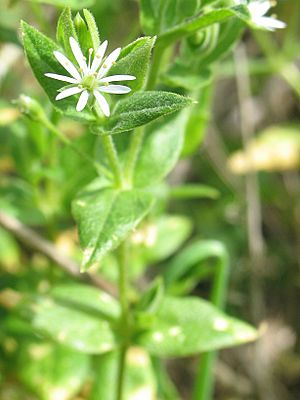Beach starwort facts for kids
Quick facts for kids Beach starwort |
|
|---|---|
 |
|
| Scientific classification | |
| Genus: |
Stellaria
|
| Species: |
littoralis
|
Stellaria littoralis, also known as beach starwort, is a beautiful flowering plant. It belongs to the Caryophyllaceae family, which includes carnations. This special plant grows only in certain parts of California. You can find it along the coast, especially in wet areas like marshes and bogs.
Contents
What is Beach Starwort?
Beach starwort is a type of plant that comes back year after year. It grows from underground stems, similar to how some grasses spread. Its stems can sprawl and branch out, reaching up to about 60 centimeters (about 2 feet) long. These stems are often hairy and have four distinct sides.
Where Does it Grow?
This plant is endemic to a specific region. This means it naturally grows nowhere else in the world! You can find it along the San Francisco Bay Area and the North Coast of California. It loves moist places near the ocean. This includes wet marshes, spongy bogs, and even coastal bluffs.
What Does it Look Like?
Beach starwort has a unique appearance. Its stems are often sprawling and can branch out quite a bit.
Stems and Leaves
The stems of the beach starwort are usually hairy. They also have a square-like shape with four distinct angles. Its leaves are arranged in pairs, one across from the other. Each leaf can be up to 4.5 centimeters (about 1.7 inches) long. They are shaped like a spearhead or a pointed oval.
Its Flowers
The plant produces several small flowers together. Each flower grows on a short stalk called a pedicel. The flower has five green, hairy parts called sepals. These sepals protect the flower bud. Inside, there are five white petals. Each petal is so deeply split that it looks like two separate petals!
Is it From California?
Stellaria littoralis looks very similar to another plant. This relative is called Stellaria dichotoma, and it grows in Asia. Scientists are still studying if beach starwort is truly a unique species. It might actually be a population of Stellaria dichotoma that arrived on the California coast a long time ago. If so, it would be an introduced species.

